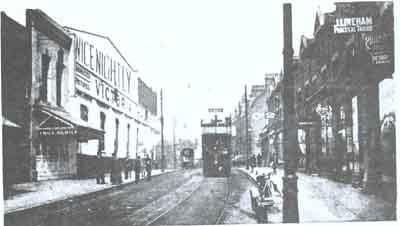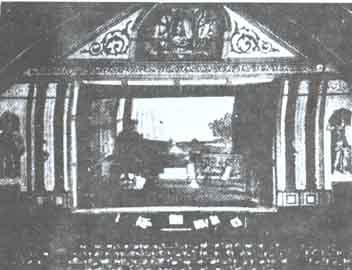 |
McGuffin's Film Society |
| Diamond Jubilee brochure | The Christie Organ | Stage shows | Request |
| Other cinemas of Walthamstow |
|
This is the text of a souvenir brochure produced to celebrate the cinema's 60th anniversary in 1990. At the time the cinema was owned by the Cannon Group, hence it was called the Cannon!
The Victoria Hall was built on this site, and opened on 2nd May 1887, with the object of providing a venue for dances, concerts, meetings and plays. It later became the King’s Theatre but reverted back to its original name in 1907, when it was converted into the first full time cinema in the area. The building was purchased by Cecil Bernstein of Granada Theatres, who decided to erect a modern Super Cinema on the site and the Victoria Hall was demolished in 1930. |
 Exterior of the Victoria Hall in 1910 after it had converted to a cinema. |
 The exterior of the Victoria Hall in 1893. |
 Interior of the Victoria Hall c1900. |
|
The site on which the Cannon cinema stands was formerly occupied by the Victoria Hall. In 1907 it was converted into the first full time cinema in the area. The building was subsequently purchased by Cecil Bernstein of Granada theatres, who had a new Super Cinema built on the site after the Victoria Hall was demolished in 1930. The architect of the 2,697 seat cinema was Cecil Massey, with interior decorations by Theodore Komisarjevsky, the famous Russian stage designer. The cinema featured a Moorish/ Spanish interior and a white painted stucco façade . This was not the first time Komisarjevsky and Massey had worked together. Their first project for the Granada circuit was the Rialto in High Road, Leytonstone; which opened on 15th June, 1911, after being converted from a roller rink. They also collaborated on a number of other theatres for Bernstein, including the Phoenix Theatre, Charing Cross Road (1930), the Granada, Woolwich, and the conversion of the Empire, Edmonton, both in 1937. Komisarjevsky produced elaborate interiors for several other Granadas, including Dover, Bedford, Clapham, Kingston, East Ham, Tooting and North Cheam. Walthamstow Granada opened on 15th September 1930, at 7.30 pm, in the presence of a number of civic dignitaries. A large queue for seats at the opening performance had begun forming at midday. The opening programme consisted of a stage show, music by a 20 piece orchestra under the baton of E J Barber, a recital of the Christie theatre organ and the feature film "Splinters" starring Nelson Keys, Sidney Howard, Hal Jones and Reg Stone. When the curtains opened for the first time, the audience saw a number of people responsible for the Granada, working away at their various tasks, sawing wood, painting etc. This later became a feature at the opening nights of the rest of the Granada circuit. Initially, the Granada operated as a "Cine-Variety" theatre, which presented a mixture of live entertainment and films. As such, it was provided with excellent stage facilities, and in later years, a number of famous stars gave concerts here. among those who have appeared at the Granada are Jerry Lee Lewis, the Beatles, the Rolling Stones, the Inkspots and P J Proby, who created a sensation when he split his trousers on stage. Tragedy struck on 16th August 1944, when a flying bomb fell on the Hoe Street/ High Street junction, killing a number of people. The theatre was badly damaged, most of the roof having been blown off. Emergency repairs were made and a temporary tarpaulin roof was installed, allowing the theatre to re-open in December of that year. In 1954, the Granada became the first cinema in the area to show a film in CinemaScope, when it presented "The Robe". Other cinemas in the area later installed CinemaScope equipment, but these were only equipped for ‘Mono’ sound, whilst the Granada was equipped for four track magnetic stereo sound. Today, Screen One is equipped with Dolby stereo sound equipment. The cinema opened as a triple screen cinema on 16th October 1973. Two cinemas were built under the Circle, and the former Circle formed the third screen. A new projection box serving all three screens was erected in the stalls. Apart from the tripling, the building is little altered. The erstwhile cafe area, which was later used as a dance studio, now houses the Victoria public house. The Cannon is a Grade Two Listed Building (McGuffin note: Today it is a Grade 2* listed building ), as are most of the remaining Granada theatres. In 1989, the theatre was taken over by the fast growing Cannon circuit and re-named the Cannon. As a part of their commitment to their cinema circuit, Cannon plan a major refurbishment of the theatre, the first stage of which will be the restorations of the stucco façade. |
|
The Christie organ installed in the Granada had two consoles, one in the orchestra pit and a portable one which could be wheeled on stage. The organ was opened by a couple billed as "Mr and Miss Smith", who were in fact the well known cinema organist Charles Willis and Miss Josie Bradley, a prominent pianist, vocalit and song writer. Charles was succeeded by Frank Matthew , who was resident organist until May 1932, when the post was filled by Harold Ramsay, "the highest paid organist in the world". Later that year, Ramsay was placed in charge of the circuit’s organists. He instituted a system by which famous organists toured the circuit on a rota basis. Thus, both Reginald (Mr Blackpool) Dixon and Sidney torch have appeared at the Granada, as have a large number of other famous organists. The orchestra pit was filled in in 1958 when Count Basie and his orchestra gave a concert at the Granada. This resulted in the console in the orchestra pit being rendered inoperative, but the portable console is still in use for regular organ concerts. Today, the organ is the only example of a Christie organ which is till in situ in a cinema. |
|
McGuffin note: If anyone is prepared to go to the library and look up any of the original reviews of these everts, carried in the local papers of that era and then send it to us either as an email (best) or as a photocopy, we could add that information to his page. |
| View pictures of film quiz | Return to top of page | Return to main page |
 The
Cannon Cinema, Walthamstow, stands on a site which has been providing
entertainment to the borough for over a century.
The
Cannon Cinema, Walthamstow, stands on a site which has been providing
entertainment to the borough for over a century.